
Do you have a question about the Mitsubishi Electric FR-A741 and is the answer not in the manual?
| Series | FR-A741 |
|---|---|
| Frequency | 50Hz/60Hz |
| Cooling Method | Forced Air Cooling |
| Ambient Temperature | -10°C to +50°C |
| Storage Temperature | -20°C to +65°C |
| Frequency Range | 0.2Hz - 400Hz |
| Control Method | V/F control, Vector Control |
| Protection Class | IP20 |
| Overload Capacity | 150% for 60s |
| Braking Unit | Built-in |
| Protection Functions | Overcurrent, Overvoltage, Undervoltage, Overheat |
| Communication | RS-485 |
| Humidity | 95% RH or less (non-condensing) |
| Altitude | Up to 1000 m above sea level |
| Vibration | 5.9 m/s² |
| Rated Output Current | Corresponds to the power range, refer to the specifications table. |
Unpack the inverter and check capacity plates to ensure product agreement and integrity.
Details essential peripheral devices like MCCBs, MCs, noise filters, and their connection.
Step-by-step instructions for safely removing and reinstalling the operation panel and front cover.
Guidelines for designing enclosures and installing inverters to ensure optimal performance and reliability.
Provides a comprehensive diagram showing all terminal connections for main and control circuits.
Details the specifications and functions of the main circuit terminals for AC power input and motor output.
Specifies recommended cable sizes and wiring lengths for optimal performance and voltage drop.
Describes the functions and specifications of various control circuit terminals for input and output signals.
Explains how to connect a motor with an encoder for vector control operation using the FR-A7AP.
Discusses measures to prevent electromagnetic noise and leakage currents affecting performance.
Recommends using magnetic contactors for safety, maintenance, and preventing automatic restarts.
Advises on measures for 400V class motors to prevent insulation deterioration due to surge voltages.
Lists important precautions for inverter operation, wiring, and handling to prevent damage or injury.
Explains how to implement failsafe measures using inverter status signals and external backups.
Provides a flowchart for performing basic inverter setup and operation, including commands and settings.
Describes the parts and functions of the FR-DU07 operation panel for monitoring and parameter adjustment.
Explains how to lock the operation panel to prevent unauthorized parameter changes or accidental operations.
Details how to monitor output current and voltage using the operation panel's SET button.
Describes the procedure for clearing individual or all parameters to their initial values.
Explains how to copy parameters between inverters and verify parameter settings.
Covers essential checks and settings before starting inverter operations, including parameter lists.
Details setting the base frequency (Pr. 3) to 50Hz when the motor is rated for 50Hz to ensure proper torque.
Explains how to adjust the Pr. 0 Torque boost parameter to improve starting torque for loads that may not rotate.
Describes how to set the upper and lower limits for the output frequency to protect the motor and system.
Explains how to set acceleration and deceleration times to control motor speed changes smoothly.
Details how to select the source for start commands and frequency commands (PU, terminals, etc.).
Guides on selecting motor parameters and control methods for high starting torque and low-speed operation.
Explains how to perform offline auto tuning to maximize motor performance by measuring constants.
Details how to perform gain adjustment for real sensorless vector and vector control for optimal performance.
Explains how to start/stop the inverter and set frequency using the PU operation panel.
Explains how to use the setting dial as a potentiometer to adjust the frequency and operate the inverter.
Guides on using external switches for start commands and multi-speed frequency settings with external operation.
Details how to set the frequency using an analog voltage input signal to terminals 2 or 4.
Explains how to set the frequency using an analog current input signal to terminal 4 for external operation.
Guides on starting and stopping the inverter and setting frequency using external terminals.
Describes how to start/stop the inverter and set frequency using terminals when Pr. 79 is set to 3.
Guides on using switches for start commands and multi-speed frequency settings with external operation.
Explains how to set the frequency using an analog voltage input signal to terminals 2 or 4 for external operation.
Guides on adjusting the maximum frequency setting for analog voltage input when using a potentiometer.
Explains how to set the frequency using an analog current input signal to terminal 4 for external operation.
Provides a categorized list of parameters for various functions, including control modes and settings.
A comprehensive list of parameters organized by their intended purpose, aiding in configuration.
Detailed list of parameters with initial values, ranges, and descriptions for easy reference and setting.
Explains how to reset the inverter after a protective function has tripped or an alarm has occurred.
Provides a comprehensive list of inverter fault and alarm indications with corresponding causes and references.
Details common causes for error messages and provides corrective actions for each.
Lists causes and corrective actions for warnings such as OL (Stall Prevention) and PS (PU Stop).
Details causes and corrective actions for alarms like FN (Fan Fault) and faults like E.OC1, E.OC2.
Lists causes and corrective actions for faults such as E.OC3, E.OV1, E.OV2, E.THT, E.THM.
Details causes and corrective actions for faults like E.OV3, E.THT, E.THM.
Lists causes and corrective actions for faults like E.FIN, E.IPF, E.UVT, E.ILF.
Details causes and corrective actions for faults like E.OLT, E.GF, E.LF, E.OHT, E.PTC.
Lists causes and corrective actions for faults like E.OPT, E.OP3, E.1 to E.3, E.PE, E.PE2.
Details causes and corrective actions for faults like E.PUE, E.RET, E.6, E.7, E.CPU, E.CTE.
Lists causes and corrective actions for faults like E.OS, E.OSD, E.ECT, E.OD.
Details causes and corrective actions for faults like E.EP, E.P24, E.CDO, E.IOH, E.SER.
Lists causes and corrective actions for faults like E.AIE, E.4, E.8, E.10.
Explains how to check and clear the inverter's faults history displayed on the operation panel.
Provides a checklist of common issues and initial checks when the motor or inverter does not operate correctly.
Discusses potential causes for abnormal inverter noise and checks to perform.
Lists checks for abnormal motor heating, including fan operation, load, and settings.
Addresses issues where speed varies during operation due to load changes, input signals, or parameter settings.
Provides troubleshooting steps when the inverter's operation mode cannot be changed correctly.
Outlines essential daily and periodic inspection items to prevent faults and ensure longevity.
Provides a detailed table for daily and periodic inspections, including descriptions and corrective actions.
Explains how to check the remaining life of inverter components like capacitors and cooling fans via the display.
Details the procedure for checking inverter and converter modules using a tester, including preparation and wiring.
Provides instructions for cleaning the inverter using a soft cloth with neutral detergent or ethanol.
Lists parts that may deteriorate with age and recommends periodic replacement based on life check functions.
Discusses the cooling fan's replacement interval, removal, and reinstallation procedures.
Guides on measuring main circuit voltages, currents, and powers using various instruments.
Details specific measuring points and recommended instruments for input and output circuits.
Explains how to measure power using electro-dynamometer type meters and highlights potential errors.
Guides on measuring inverter input and output voltages, recommending specific voltmeter types.
Details methods for measuring inverter input and output currents, including frequency considerations.
Advises on using CTs and transducers for current measurement, considering VA ability and harmonics.
Explains how to calculate the inverter input power factor using effective and apparent power.
Describes how to measure converter output voltage and its behavior under no load and regenerative conditions.
Details how to measure inverter output frequency using FM terminal signal output.
Guides on performing insulation resistance tests on the main circuit, excluding the control circuit.
Provides the electrical ratings for the FR-A721 and FR-A741 series inverters, including capacity and current.
Details the ratings for SF-V5RU(H) motors, including applicable inverter types, output, and torque.
Outlines common specifications for the inverters, including control methods, input signals, and operational functions.
Provides outline dimension drawings for FR-A721/A741 inverters of 5.5K to 15K capacity.
Provides outline dimension drawings for SF-V5RU(H) motors (standard horizontal type) for various frame numbers.
Advises on installing the heatsink portion outside the enclosure to reduce internal heat generation.
Summarizes the main differences and compatibilities between the FR-A700 and FR-A701 series inverters.
Provides instructions for UL and cUL compliance regarding installation, wiring, and short circuit ratings.
Provides a table mapping parameters to control modes and instruction codes for RS-485 communication.
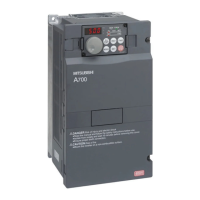
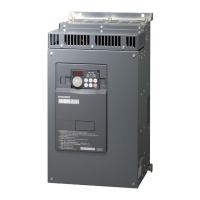



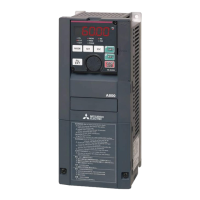
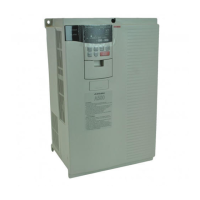

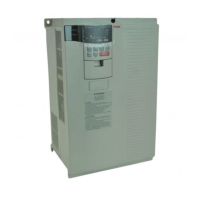



